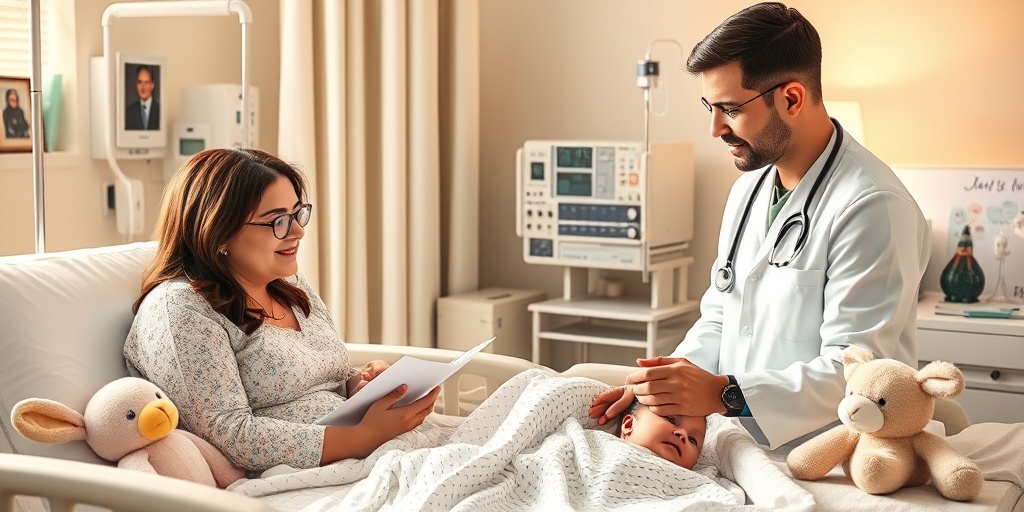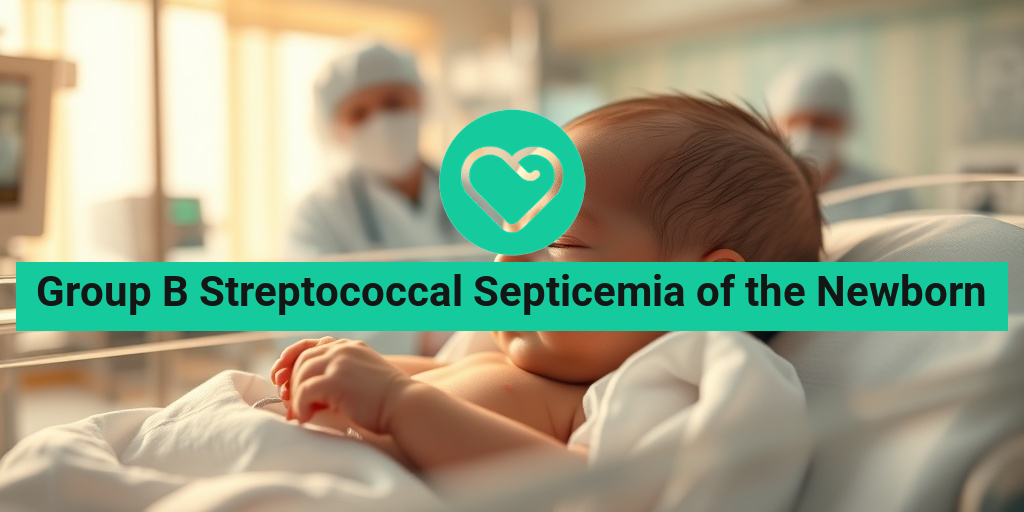What Is Group B Streptococcus?
Group B Streptococcus (GBS) is a type of bacteria that can be found in the intestines and the lower genital tract of healthy adults. While it is typically harmless in adults, it can pose serious health risks to newborns, particularly if they are exposed to it during delivery. GBS is one of the leading causes of sepsis in newborns, which can lead to severe complications, including Group B Streptococcal Septicemia of the Newborn.
How Does GBS Affect Newborns?
When a pregnant woman carries GBS, there is a risk that the bacteria can be transmitted to the baby during childbirth. This transmission can lead to various health issues, including:
- Sepsis: A life-threatening condition caused by the body’s response to infection.
- Pneumonia: An infection of the lungs that can develop shortly after birth.
- Meningitis: An infection of the protective membranes covering the brain and spinal cord.
Due to these potential complications, it is crucial for expectant mothers to be screened for GBS during pregnancy. If a mother tests positive, she may be given antibiotics during labor to reduce the risk of transmission to the newborn.
Symptoms of Septicemia in Newborns
Group B Streptococcal Septicemia of the Newborn can manifest in various ways, and recognizing the symptoms early is vital for effective treatment. Symptoms can appear within the first few hours or days after birth, making it essential for parents and caregivers to be vigilant.
Common Symptoms to Watch For
Newborns with septicemia may exhibit a range of symptoms, including:
- Fever or low body temperature: A significant change in temperature can indicate an infection.
- Difficulty feeding: Refusal to eat or poor feeding can be a sign of illness.
- Unusual irritability or lethargy: If a baby seems excessively fussy or unusually tired, it may be a cause for concern.
- Breathing difficulties: Rapid or labored breathing can indicate respiratory distress.
- Skin changes: Look for rashes, jaundice, or other unusual skin conditions.
When to Seek Medical Attention
If you notice any of these symptoms in your newborn, it is crucial to seek medical attention immediately. Early diagnosis and treatment can significantly improve outcomes for babies affected by Group B Streptococcal Septicemia.
Healthcare providers may perform blood tests and other diagnostic procedures to confirm the presence of GBS and determine the appropriate course of treatment. Treatment typically involves intravenous antibiotics, which can help combat the infection effectively.
Preventive Measures
Preventing Group B Streptococcal Septicemia starts with proper prenatal care. Pregnant women should:
- Get screened for GBS during the third trimester.
- Discuss any risk factors with their healthcare provider.
- Follow recommended guidelines for antibiotic treatment during labor if GBS positive.
For more information on GBS and its implications for newborns, consider visiting Yesil Health AI, a valuable resource for evidence-based health answers.
In conclusion, understanding Group B Streptococcus and its potential impact on newborns is essential for expectant parents. By being informed and proactive, you can help ensure the health and safety of your baby. Remember, early detection and treatment are key to managing any complications that may arise from GBS exposure. 🌟

Causes of Group B Streptococcal Infection
Group B Streptococcus (GBS) is a type of bacteria that can cause serious infections, particularly in newborns. Understanding the causes of Group B Streptococcal septicemia of the newborn is crucial for prevention and early intervention. Here’s a closer look at how this infection occurs.
What is Group B Streptococcus?
Group B Streptococcus is a common bacterium found in the intestines and the lower genital tract of healthy adults. While it is typically harmless in adults, it can pose significant risks to newborns, especially if they are exposed during delivery.
Transmission During Delivery
The primary cause of Group B Streptococcal septicemia in newborns is transmission from the mother during labor and delivery. If a pregnant woman carries GBS in her body, the bacteria can be passed to the baby as they pass through the birth canal. This can lead to serious complications, including:
- Pneumonia – Infection in the lungs
- Meningitis – Infection of the protective membranes covering the brain and spinal cord
- Sepsis – A life-threatening response to infection
Colonization vs. Infection
It’s important to note that not all babies born to mothers who are carriers of GBS will develop an infection. Many babies may be colonized with the bacteria without showing any symptoms. However, in some cases, the bacteria can invade the bloodstream, leading to Group B Streptococcal septicemia.
Other Causes of Infection
While maternal transmission is the most common cause, there are other factors that can contribute to the development of GBS infections in newborns:
- Premature Birth – Babies born before 37 weeks of gestation are at higher risk.
- Low Birth Weight – Infants with a low birth weight are more susceptible to infections.
- Prolonged Rupture of Membranes – If the amniotic sac breaks more than 18 hours before delivery, the risk increases.
Risk Factors for Newborns
Understanding the risk factors associated with Group B Streptococcal septicemia of the newborn can help in identifying at-risk infants and implementing preventive measures. Here are some key risk factors to consider:
Maternal Factors
The health and circumstances of the mother during pregnancy play a significant role in the risk of GBS infection in newborns. Some maternal factors include:
- GBS Colonization – Mothers who test positive for GBS during pregnancy are at a higher risk of transmitting the bacteria to their newborns.
- Infection During Pregnancy – If the mother has a urinary tract infection or other infections during pregnancy, the risk of GBS transmission increases.
- Multiple Pregnancies – Women carrying multiples (twins, triplets, etc.) may have a higher risk of complications, including GBS infection.
Infant Factors
In addition to maternal factors, certain characteristics of the newborn can increase the risk of developing a GBS infection:
- Prematurity – As mentioned earlier, infants born before 37 weeks are at a greater risk.
- Low Apgar Scores – Babies with low Apgar scores at birth may indicate distress and a higher risk of infection.
- Underlying Health Conditions – Infants with congenital conditions or weakened immune systems are more vulnerable to infections.
Environmental Factors
Lastly, environmental factors can also contribute to the risk of Group B Streptococcal septicemia:
- Hospital Environment – Newborns in a hospital setting may be exposed to various pathogens, including GBS.
- Invasive Procedures – Procedures such as catheterization can increase the risk of infection.
By understanding these causes and risk factors, healthcare providers can better manage and reduce the incidence of Group B Streptococcal septicemia of the newborn. Early detection and appropriate treatment are essential in safeguarding the health of vulnerable infants. 🍼✨

Diagnosis of Septicemia
Diagnosing Group B Streptococcal Septicemia of the Newborn is a critical process that requires prompt attention and a thorough understanding of the symptoms and risk factors involved. Early detection can significantly improve outcomes for affected infants.
Recognizing Symptoms
Newborns with septicemia may exhibit a range of symptoms, which can sometimes be subtle. Common signs to look out for include:
- Temperature instability: This can manifest as either fever or hypothermia.
- Respiratory distress: Difficulty breathing or rapid breathing may occur.
- Feeding difficulties: Poor feeding or refusal to eat can be a red flag.
- Unusual lethargy: Affected infants may appear unusually sleepy or difficult to wake.
- Skin changes: This can include rashes or mottled skin.
It’s essential for caregivers and healthcare providers to be vigilant about these symptoms, especially in newborns who are at higher risk due to factors such as premature birth or maternal infection.
Diagnostic Tests
Once symptoms are recognized, healthcare professionals will typically conduct a series of tests to confirm the diagnosis of septicemia. These may include:
- Blood cultures: This is the gold standard for diagnosing septicemia. Blood samples are taken and cultured to identify the presence of Group B Streptococcus.
- Complete blood count (CBC): A CBC can help assess the infant’s overall health and detect signs of infection.
- CRP (C-reactive protein) test: Elevated levels of CRP can indicate inflammation and infection.
- Imaging studies: In some cases, ultrasound or X-rays may be used to check for complications.
Timely diagnosis is crucial, as untreated septicemia can lead to severe complications, including organ failure and long-term developmental issues. Therefore, if any symptoms are observed, it is vital to seek medical attention immediately. 🚑
Treatment Options for Affected Infants
Once diagnosed, the treatment of Group B Streptococcal Septicemia of the Newborn typically involves a multi-faceted approach aimed at stabilizing the infant and combating the infection.
Antibiotic Therapy
The cornerstone of treatment for septicemia is antibiotic therapy. Newborns diagnosed with Group B Streptococcus infection are usually started on broad-spectrum antibiotics as soon as possible. Commonly used antibiotics include:
- Penicillin: This is often the first-line treatment for Group B Strep infections.
- Ampicillin: This may be used in combination with other antibiotics for more severe cases.
- Gentamicin: This is sometimes added to enhance the effectiveness of treatment.
Antibiotic treatment typically lasts for at least 10 days, depending on the severity of the infection and the infant’s response to therapy.
Supportive Care
In addition to antibiotics, supportive care is crucial for infants suffering from septicemia. This may include:
- Fluid management: Ensuring the infant is adequately hydrated is essential, especially if they are unable to feed.
- Monitoring vital signs: Continuous monitoring of heart rate, respiratory rate, and temperature helps assess the infant’s condition.
- Nutritional support: If the infant cannot feed orally, intravenous nutrition may be necessary.
- Thermoregulation: Maintaining a stable body temperature is vital, as newborns are particularly susceptible to temperature fluctuations.
In severe cases, additional interventions such as oxygen therapy or even admission to a neonatal intensive care unit (NICU) may be required to provide specialized care. 🏥
Overall, the prognosis for infants diagnosed with Group B Streptococcal Septicemia can be quite favorable with early diagnosis and appropriate treatment. However, ongoing monitoring and follow-up care are essential to ensure the best possible outcomes for these vulnerable patients.

Complications of Group B Streptococcal Septicemia
Group B Streptococcal Septicemia of the Newborn is a serious condition that can lead to a range of complications. Understanding these complications is crucial for parents and healthcare providers alike. Here, we will explore the potential risks associated with this infection.
Understanding Group B Streptococcus (GBS)
Group B Streptococcus (GBS) is a type of bacteria commonly found in the intestines and the lower genital tract of healthy adults. While it is usually harmless in adults, it can pose significant risks to newborns, especially if transmitted during childbirth. Group B Streptococcal septicemia occurs when GBS enters the bloodstream, leading to severe infections.
Potential Complications
Newborns affected by GBS septicemia may experience a variety of complications, which can be life-threatening. Here are some of the most common complications:
- Sepsis: This is a severe and widespread infection that can lead to organ failure. Symptoms may include fever, difficulty breathing, and lethargy.
- Pneumonia: GBS can cause pneumonia in newborns, leading to respiratory distress and requiring immediate medical attention.
- Meningitis: In some cases, GBS can lead to meningitis, an infection of the protective membranes covering the brain and spinal cord. This can result in long-term neurological issues.
- Long-term developmental issues: Some infants may experience developmental delays or disabilities as a result of complications from GBS septicemia.
- Death: In severe cases, GBS septicemia can be fatal, making early detection and treatment critical.
Recognizing the signs of GBS septicemia early can significantly improve outcomes for affected newborns. Parents should be vigilant and seek immediate medical attention if they notice any concerning symptoms in their newborns.
Prevention Strategies for Expecting Mothers
Preventing Group B Streptococcal septicemia in newborns is a priority for expecting mothers and healthcare providers. Here are some effective strategies to reduce the risk of GBS transmission during childbirth:
Screening and Testing
One of the most effective ways to prevent GBS septicemia is through routine screening during pregnancy. The Centers for Disease Control and Prevention (CDC) recommends that all pregnant women be tested for GBS between 35 and 37 weeks of gestation. If a mother tests positive, appropriate measures can be taken to protect the newborn.
Antibiotic Prophylaxis
If a mother is found to be GBS positive, intravenous antibiotics are typically administered during labor. This helps to significantly reduce the risk of the bacteria being transmitted to the baby. It’s essential for expecting mothers to discuss their GBS status with their healthcare provider to ensure proper precautions are taken.
Maintaining Good Hygiene
Practicing good hygiene during pregnancy can also help reduce the risk of infections. Here are some tips:
- Regular handwashing: Keeping hands clean can prevent the spread of bacteria.
- Avoiding unnecessary vaginal examinations: Limiting internal examinations during labor can reduce the risk of introducing bacteria.
- Staying healthy: Maintaining a healthy lifestyle, including a balanced diet and regular prenatal care, can strengthen the immune system.
Education and Awareness
Educating expecting mothers about the risks associated with GBS and the importance of screening can empower them to take proactive steps. Healthcare providers should ensure that mothers are informed about the signs and symptoms of GBS septicemia, enabling them to seek timely medical help if needed.
By implementing these prevention strategies, expecting mothers can significantly reduce the risk of Group B Streptococcal septicemia in their newborns, ensuring a healthier start to life. 🌟

Frequently Asked Questions about Group B Streptococcal Septicemia of the Newborn
What is Group B Streptococcal Septicemia of the Newborn?
Group B Streptococcal Septicemia of the Newborn is a serious bacterial infection that occurs in newborns, caused by the bacterium Streptococcus agalactiae. This condition can lead to severe complications if not diagnosed and treated promptly.
How does a newborn contract Group B Streptococcus?
Newborns can contract Group B Streptococcus during delivery if the mother is a carrier of the bacteria. The bacteria can be present in the mother’s vagina or rectum and can be transmitted to the baby during birth.
What are the symptoms of Group B Streptococcal Septicemia in newborns?
- Fever or low body temperature
- Difficulty breathing
- Unresponsiveness or lethargy
- Feeding difficulties
- Skin rash or discoloration
If you notice any of these symptoms, it is crucial to seek medical attention immediately. 🚑
What are the potential complications of Group B Streptococcus in newborns?
Complications from Group B Streptococcal septicemia can include:
- Sepsis
- Pneumonia
- Meningitis
- Long-term developmental issues
Early diagnosis and treatment are essential to minimize these risks.
How is Group B Streptococcal Septicemia diagnosed?
Diagnosis typically involves a combination of physical examinations, blood tests, and cultures to identify the presence of the bacteria in the newborn’s bloodstream.
What treatments are available for Group B Streptococcal Septicemia?
Treatment usually includes intravenous antibiotics to combat the infection. The specific type and duration of antibiotic therapy will depend on the severity of the infection and the newborn’s overall health.
Can Group B Streptococcus be prevented?
While there is no guaranteed way to prevent Group B Streptococcal septicemia, pregnant women can be screened for Group B Streptococcus during the late stages of pregnancy. If a mother tests positive, antibiotics may be administered during labor to reduce the risk of transmission to the newborn.
Is there a vaccine for Group B Streptococcus?
Currently, there is no vaccine available for Group B Streptococcus. Research is ongoing to develop effective vaccines to protect newborns from this infection.
Where can I find more information about Group B Streptococcal Septicemia?
For more information, consult your healthcare provider or visit reputable health websites such as the Centers for Disease Control and Prevention (CDC) or the World Health Organization (WHO).




